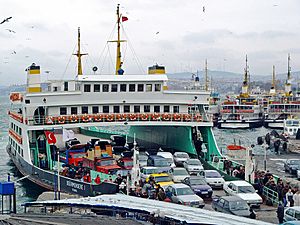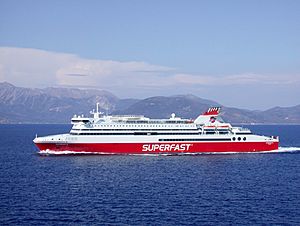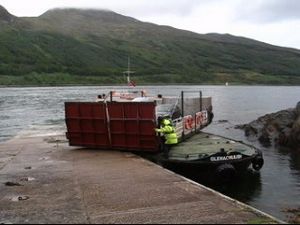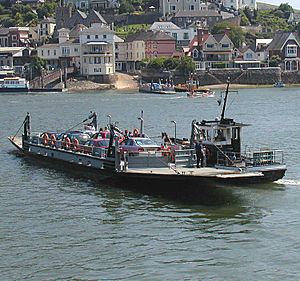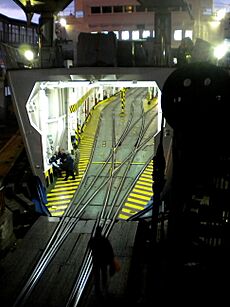Ferry facts for kids


A ferry is a special boat or ship. It helps people, cars, or goods cross large areas of water. This could be a sea, a lake, or a river.
Ferries are super important for public transport in many parts of the world. Some places can only be reached by ferry. This is because they don't have roads or railways with bridges or tunnels. They also might not have places for airplanes to land.
Sometimes, riding a ferry is free. Other times, you need to buy a ticket. Many ferries can carry cars. Some even have rail tracks to carry whole trains! The word 'ferry' can also mean the act of taking someone or something across water by boat.
Contents
Different Kinds of Ferries
Ferry designs change based on what they need to do. This includes how long the trip is, how many people or cars they carry, how fast they need to go, and the water conditions.
Double-Ended Ferries
Double-ended ferries are cool because they don't need to turn around. They have a front and a back that can both act as the bow or stern. This lets them go back and forth between two terminals easily. Famous examples include the Staten Island Ferry and Washington State Ferries. Many ferries in Norway and Canada are also double-ended. In 2008, BC Ferries launched some of the biggest double-ended ferries ever.
Hydrofoil Ferries
Hydrofoils are known for their speed. They have special "wings" under the water that lift the hull as they speed up. This reduces drag and allows them to go much faster. They used to be popular for passenger-only routes, like in the Canary Islands. However, many have been replaced by larger, faster catamarans that can also carry cars.
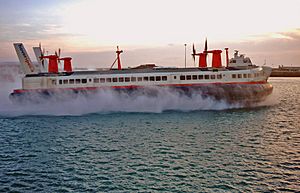
Hovercraft Ferries
Hovercrafts were developed in the 1960s and 1970s. They float on a cushion of air, which lets them travel over both water and land. The largest hovercraft, the SR.N4, could carry cars between England and France. Today, most hovercraft car services have been replaced by catamarans. Only one passenger hovercraft service remains in the UK, between Portsmouth and the Isle of Wight.
Catamaran Ferries
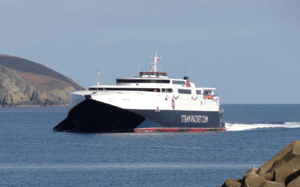
Since the 1990s, high-speed Catamarans have changed ferry services a lot. They have two parallel hulls, which makes them very stable and fast. They have replaced many hovercraft, hydrofoils, and older single-hull ferries. Companies like Incat and Austal are famous for building these large, fast ferries.
Stena Line once operated the huge Stena HSS class catamarans. These ships could carry 375 cars and 1,500 passengers. They were powered by waterjets and were among the largest catamarans in the world.
Roll-on/Roll-off (RORO) Ferries
Roll-on/roll-off ferries, often called RORO ferries, are large traditional ferries. Their name comes from how easy it is for vehicles to drive directly onto and off the ship. They have large ramps at the front, back, or sides.
Cruiseferries
A cruiseferry is a special type of ship. It combines the fun features of a cruise ship with the ability of a RORO ferry to carry vehicles. So, you can enjoy a mini-cruise while your car travels with you!
Fast RoPax Ferries
Fast RoPax ferries are modern ferries that can carry many vehicles and passengers. They use regular diesel engines and propellers. These ferries can travel very fast, often over 25 knots (about 46 kilometers per hour). They usually have smaller cabins than cruise ships. Attica Group was a pioneer in this class with their Superfast I in 1995.
Turntable Ferries
This type of ferry lets vehicles load from the side. The vehicle platform on the ferry can turn. When loading, the platform turns sideways for cars to drive on. Then, it turns back in line with the vessel for the journey.
Pontoon Ferries
Pontoon ferries carry vehicles across rivers and lakes. They are often used in places where building a bridge would be too expensive. One or more vehicles drive onto a flat pontoon, which has ramps at each end. Some pontoon ferries are pulled by tugs, while others are motorized and can steer themselves.
Train Ferries
A train ferry is a ship made to carry railway vehicles. One level of the ship has railway tracks. The vessel has a door at the front or back (or both) to let trains drive on and off the tracks.
Foot Ferries
Foot ferries are smaller boats used to carry people, and often cyclists, across rivers. These can be self-propelled boats or cable ferries. You can find them on rivers like the River Scheldt in Belgium and the Netherlands. There are also foot ferries in Prague, Czech Republic, and Melbourne, Australia.
Cable Ferries
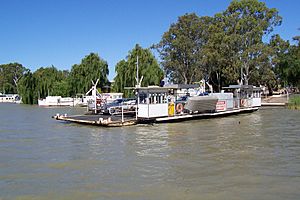
For very short distances, a cable or chain ferry might be used. These are usually pontoon ferries. They are pulled along and steered by cables connected to each shore. Sometimes, a person on the boat powers the ferry. Reaction ferries are a type of cable ferry that use the river's current to move. For example, four Rhine ferries in Basel, Switzerland, use the current.
Many free ferries operate around the world. Examples include the Woolwich ferry in London, England (across the River Thames), and ferries in Amsterdam, Netherlands (across the IJ waterway). The New York Harbor has a famous free ferry connecting Manhattan to Staten Island. Many cable ferries are found on lakes and rivers in Canada.
Air Ferries
In the 1950s and 1960s, you could travel by "air ferry". These were airplanes, often old military planes, specially set up to carry a few cars along with passengers. They flew routes between the United Kingdom and Continental Europe. Companies like Channel Air Bridge offered these services. The term "air ferry" is also used for any "ferrying" by air, especially in military operations.
Images for kids
-
Mark 3 SR.N4 hovercraft, Dover
-
MS Silja Symphony leaving Helsinki via the Kustaanmiekka strait to the Baltic Sea.
-
A road ferry between Oulu and the Hailuoto Island on the Bothnian Bay.
-
MV Spirit of Vancouver Island on its way to Tsawwassen from Swartz Bay. This is BC Ferries' busiest route.
-
Alaska Marine Highway System ferries MV LeConte and MV Kennicott near Juneau, Alaska.
-
MS Spirit of Tasmania II at port in Devonport, Australia.
See also
 In Spanish: Transbordador para niños
In Spanish: Transbordador para niños



